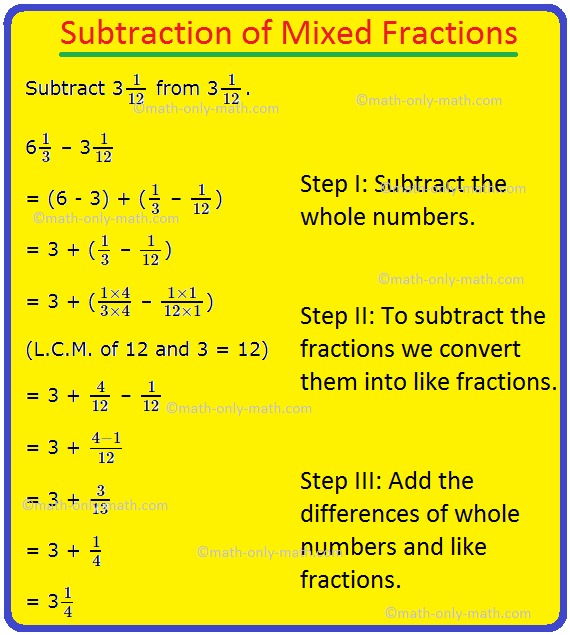Subscribe to our ▶️ YouTube channel 🔴 for the latest videos, updates, and tips.
Subtraction of Mixed Fractions
We will learn how to solve subtraction of mixed fractions or subtraction of mixed numbers.
There are two methods to subtract the mixed fractions.
1. Subtract 3\(\frac{1}{12}\) from 3\(\frac{1}{12}\).
Solution:
Method I.
|
6\(\frac{1}{3}\) – 3\(\frac{1}{12}\) = (6 - 3) + (\(\frac{1}{3}\) – \(\frac{1}{12}\)) = 3 + (\(\frac{1}{3}\) – \(\frac{1}{12}\)) = 3 + (\(\frac{1 × 4}{3 × 4}\) – \(\frac{1 × 1}{12 × 1}\)) (L.C.M. of 12 and 3 = 12) = 3 + \(\frac{4}{12}\) – \(\frac{1}{12}\) = 3 + \(\frac{4 - 1}{12}\) = 3 + \(\frac{3}{13}\) = 3 + \(\frac{1}{4}\) = 3\(\frac{1}{4}\) |
Step I: Subtract the whole numbers.
Step II: To subtract the fractions we convert them into like fractions. Step III: Add the differences of whole numbers and like fractions. |
Method II:
|
6\(\frac{1}{3}\) – 3\(\frac{1}{12}\)
= \(\frac{(6 × 3) + 1}{3}\) + \(\frac{(3 × 12) + 1}{12}\) = \(\frac{19}{3}\) – \(\frac{37}{12}\) = \(\frac{19 × 4}{3 × 4}\) – \(\frac{37 × 1}{12 × 1}\), (L.C.M. of 3 and 12 = 12) = \(\frac{76}{12}\) – \(\frac{37}{12}\) = \(\frac{76 - 37}{12}\) = \(\frac{39}{12}\) = \(\frac{13}{4}\) = 3\(\frac{1}{4}\) |
Step I: Change the mixed numbers into improper fractions. Step II: Make the fractions like fraction to have a common denominator. Step III: Subtract and express the fraction in the simplest form. |
2. Subtract 1\(\frac{5}{12}\) from 3\(\frac{3}{8}\)
Solution:
We first convert the mixed numbers into improper fractions.
1\(\frac{5}{12}\) = \(\frac{1 × 12 + 5}{12}\) = \(\frac{17}{12}\)
3\(\frac{3}{8}\) = \(\frac{3 × 8 + 3}{8}\) = \(\frac{27}{8}\)
Now, \(\frac{27}{8}\) - \(\frac{17}{12}\) = \(\frac{27 × 3}{8 × 3}\) - \(\frac{17 × 2}{12 × 2}\)
LCM of 8 and 12 is 24
\(\frac{81}{24}\) - \(\frac{34}{24}\) = \(\frac{81 - 34}{24}\)
= \(\frac{47}{24}\)
= 1\(\frac{23}{24}\)
Hence, 3\(\frac{3}{8}\) - 1\(\frac{5}{12}\) = 1\(\frac{23}{24}\)
Word Problems on Subtraction of Mixed Fractions:
3. Ron used 3\(\frac{1}{4}\) litres of paint from a tin of 5\(\frac{1}{2}\) l, to color the walls of his room. What fraction of paint is still left in the tin?
Answer: \(\frac{9}{4}\) litres
4. Sam has a cloth of length 16 m. He took 13\(\frac{1}{4}\) m of cloth from it to make curtains for the house. How much cloth is still left with him for further use?
Answer: 2\(\frac{3}{4}\) m
5. Ten years ago a forest was spread up to a distance of 33 km. Due to forest fires and industrial set up now it is spread upto a distance of 16\(\frac{1}{5}\) km. What fraction of forest has been destroyed in the last 10 years? What measures can be taken to protect these forests?
Answer: 16\(\frac{4}{5}\) km
6. A drum full of rice weighs 84\(\frac{1}{2}\) kg. If the weight of empty drum is 12\(\frac{1}{6}\) kg, find the weight of the rice.
Answers: 72\(\frac{1}{3}\) kg
● Related Concepts
- Fraction of a Whole Numbers
- Representation of a Fraction
- Equivalent Fractions
- Properties of Equivalent Fractions
- Finding Equivalent Fractions
- Reducing the Equivalent Fractions
- Verification of Equivalent Fractions
- Finding a Fraction of a Whole Number
- Like and Unlike Fractions
- Comparison of Like Fractions
- Comparison of Fractions having the same Numerator
- Comparison of Unlike Fractions
- Fractions in Ascending Order
- Fractions in Descending Order
- Types of Fractions
- Changing Fractions
- Conversion of Fractions into Fractions having Same Denominator
- Conversion of a Fraction into its Smallest and Simplest Form
- Addition of Fractions having the Same Denominator
- Addition of Unlike Fractions
- Addition of Mixed Fractions
- Word Problems on Addition of Mixed Fractions
- Worksheet on Word Problems on Addition of Mixed Fractions
- Subtraction of Fractions having the Same Denominator
- Subtraction of Unlike Fractions
- Subtraction of Mixed Fractions
- Word Problems on Subtraction of Mixed Fractions
- Worksheet on Word Problems on subtraction of Mixed Fractions
- Addition and Subtraction of Fractions on the Fraction Number Line
- Word Problems on Multiplication of Mixed Fractions
- Worksheet on Word Problems on Multiplication of Mixed Fractions
- Multiplying Fractions
- Dividing Fractions
- Word Problems on Division of Mixed Fractions
- Worksheet on Word Problems on Division of Mixed Fractions
From Subtraction of Mixed Fractions to HOME PAGE
Didn't find what you were looking for? Or want to know more information about Math Only Math. Use this Google Search to find what you need.



New! Comments
Have your say about what you just read! Leave me a comment in the box below. Ask a Question or Answer a Question.